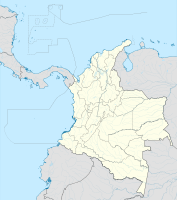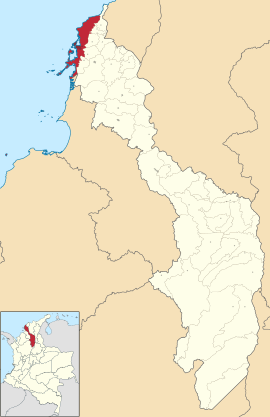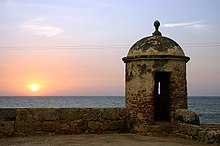Cartagena (Colombia)
| Cartagena de Indias | ||
|---|---|---|
|
Coordinates: 10 ° 25 ′ N , 75 ° 32 ′ W Cartagena de Indias on the map of Colombia
|
||
|
Location of the municipality of Cartagena on the map of Bolívar
|
||
| Basic data | ||
| Country | Colombia | |
| Department | Bolívar | |
| City foundation | 1533 | |
| Residents | 1,047,005 (2019) | |
| - in the metropolitan area | 1,382,015 | |
| City insignia | ||
| Detailed data | ||
| surface | 630 km 2 | |
| Population density | 1,662 inhabitants / km 2 | |
| height | 2 m | |
| Time zone | UTC -5 | |
| City Presidency | William Dau Chamat (2020-2023) | |
| Website | ||
Cartagena de Indias is a municipality ( municipio ) on the Caribbean coast of Colombia and the capital of the Bolívar department . The name of the city comes from the Spanish city of Cartagena , with the addition of de Indias in relation to the West Indies to distinguish it .
geography
Cartagena is located on the Caribbean coast in the north of the country with access to both the open sea and the Bahía de Cartagena de Indias . Inland it is protected by a mountain range. The municipality borders the Caribbean to the west and north, Santa Catalina , Clemencia , Santa Rosa , Turbaco and Turbaná to the east and San Onofre (Colombia) in the Sucre Department to the south . The municipality includes the Isla de Tierra Bomba , which closes the Bahía de Cartagena de Indias to the sea, the Barú peninsula and the Islas del Rosario archipelago south of the urban area. In addition, the San Bernardo Archipelago and Santa Cruz del Islote off the coast of Sucre and Isla Fuerte off the coast of Córdoba also belong to the municipality.
- Metropolitan area
In addition to Cartagena, the unofficial metropolitan area of Cartagena includes the municipalities of Arjona , Clemencia , Mahates , María La Baja , San Estanislao , Santa Catalina , Santa Rosa , Turbaco , Turbaná and Villanueva .
| Cartagena | ||||||||||||||||||||||||||||||||||||||||||||||||
|---|---|---|---|---|---|---|---|---|---|---|---|---|---|---|---|---|---|---|---|---|---|---|---|---|---|---|---|---|---|---|---|---|---|---|---|---|---|---|---|---|---|---|---|---|---|---|---|---|
| Climate diagram | ||||||||||||||||||||||||||||||||||||||||||||||||
| ||||||||||||||||||||||||||||||||||||||||||||||||
|
Average monthly temperatures and rainfall for Cartagena
Source: wetterkontor.de
|
|||||||||||||||||||||||||||||||||||||||||||||||||||||||||||||||||||||||||||||||||||||||||||||||||||||||||||||||||||||||||||||||||||||||||||||||||||||||||||||||||||||||||||||||||||||||||||||||||||
population
The municipality of Cartagena has 1,047,005 inhabitants, of which 1,005,981 live in the urban part (cabecera municipal) of the municipality. 1,382,015 people live in the metropolitan region (as of 2019).
history
The city was founded by Pedro de Heredia on June 1, 1533 during the colonization of South America . During the conquest and the founding of the city, the Spanish conquistador received support from India Catalina . Cartagena is one of the first Spanish cities to be founded in North South America and experienced rapid growth as an important port for the continent's shipping . The Spanish fleet came to Cartagena twice a year from Seville or Cádiz to market Spanish goods such as weapons, armor, tools, textiles and horses and to load gold, silver, pearls and precious stones before sailing on to Puerto Bello and Santo Domingo .
The Dutch and English slave ships, insofar as they were allowed to enter Spanish ports in America, had to go to Cartagena. For this reason, Cartagena was often attacked and looted by pirates , for example in 1585 by Sir Francis Drake , in 1697 by the French under Jean-Bernard Louis de Saint-Jean, Baron de Pointis , known as Bernard Desjean, and Jean Baptiste du Casse . After the Drake invasion, the residents fortified the city with an eleven-kilometer-long protective wall and the huge San Felipe fortification . The entrance to the bay was now lined by two forts, San José and San Fernando , which were difficult to negotiate.
The churches in the city also resemble defensive structures. From 1575 to 1585 the cathedral of the Roman Catholic Archdiocese of Cartagena was built, from 1570 to 1612 the Santo Domingo Monastery was built; in the 17th century the Jesuit monastery La Compania was added. As early as 1610, the Spanish Inquisition was introduced in Cartagena, which moved into its own palace in 1770 and played a powerful role here. Cartagena has been called the Pearl of Las Indias . The stored treasures that were to be transported to Spain and the steadily arriving and departing ships made the port city very quickly a preferred destination for privateers and pirates. With the help of slaves from Africa, a powerful protective wall and a total of 29 forts were built. After England declared war on Spain in the War of Jenkins' Ear , Admiral Edward Vernon was sent with a force of 186 ships and 18,000 men to take Cartagena under Don Blas de Lezo . The largest attack in Cartagena's history, which began on March 13, 1741, had to be abandoned two months later, as there was no longer any prospect of a victory for the English and Vernon's fleet was worn down by yellow fever and malaria. After an attack by English pirates in 1741, against which Cartagena was also able to assert itself, the city was temporarily considered impregnable and the example of Spanish military architecture.
In the 17th century, the Jesuit Pedro Claver did not limit his help for the countless black slaves that were auctioned here to mass baptisms, but instead worked as a physician to improve the inhumane conditions under which the slaves had to suffer. He was canonized for this by the Catholic Church.
In November 1811, the liberator of South America, Simón Bolívar , declared independence for Cartagena and the end of the Inquisition under the influence of the French Revolution and the Napoleonic occupation of the mother country. But the Spaniards did not want to let their colonies go so unopposed: In December 1815, after the withdrawal of Napoleonic troops from Spain and the restoration of the Spanish monarchy, Spanish associations under Pablo Morillo recaptured the colony. Only after the Battle of Boyacá in 1821 and further clashes in the spring of 1822 did Cartagena and the colony achieve internationally recognized independence from the Spanish motherland.
Culture and sights
The place has established itself as one of the most beautiful colonial cities in South America. Cartagena is the city with the most tourists and, not least because of its geographical location, the safest and best guarded city in Colombia. As in all large cities, caution is advised because of petty crime. Cartagena is hardly affected by the armed conflict between the military, paramilitaries ( AUC ) and guerrillas ( FARC , ELN ). The Colombian Navy has its main base in Cartagena.
The completely walled old city center with fortress ring and the districts Centro with the cathedral and countless palaces in the Andalusian style, San Diego , the quarter of the merchants and the numerically small bourgeoisie as well as Getsemaní , the quarter of the little people and craftsmen, which dates from this time, 1959 was declared a national Monument and is since 1984 UNESCO - world heritage Site . The huge hotel zone, Bocagrande , is located on a promontory next to the walled old town .
The Caribbean nightlife in Cartagena de Indias is legendary; a tourist specialty is rumba en chiva , a party on the bus. Most of the nightclubs are on Calle Arsenal, Getsemaní. Smaller clubs and restaurants are located in the historic center of the city. The Afro-Caribbean style of music, Champeta , originated in Cartagena and is heard and celebrated primarily in the poor areas of the city.
Every year the international Cartagena Film Festival , the FICCI ( Festival Internacional de Cine de Cartagena de Indias ) takes place here .
Economy and Infrastructure
The inhabitants are largely of African descent. The main sources of income include fishing , tourism, ship freight and the oil industry . The main exports are oil, coffee and platinum.
Oil refineries, chemical and petrochemical industries are located here.
The international airport Aeropuerto Internacional Rafael Núñez (IATA: CTG, ICAO: SKCG) is located in the northeast of the city.
Port facilities
In the southwest there are over 40 seaports for commercial and sport shipping. The port is Colombia's most important oil and container port. The operators of the three largest container ports are Sociedad Portuaria de Cartagena de Indias , Muelles El Bosque and Terminal de Contenedores de Cartagena de Indias . There are also u. a. the following operating ports : Reficar (refinery), SABMiller , Argos, Dow Chemical , BASF Colombia, DuPont , Cemex , Dole Food Company and Colombian Navy Steelworks .
Others
The Nobel Prize for Literature, Gabriel García Márquez , commemorated Cartagena in his 1985 novel Love in the Times of Cholera . In Cartagena in 1990 the drug summit took place with the presidents of Colombia , Peru , Bolivia and the USA , at which measures against the cultivation of coca bushes and the extraction of cocaine were discussed.
Also in Cartagena in 2003 there was a conference on the cross-border transport, handling and handling of genetically modified organisms, the result of which was a binding international agreement on biological safety, known as the Cartagena Protocol for short , which was adopted on September 11, 2003.
Every year the national beauty contest Miss Colombia takes place here.
Cartagena has a university, the Universidad de Cartagena , and is the seat of an archbishop .
The high-rise project Torre de la Escollera , started in 2005, was dismantled after storm damage in 2007.
Much of the Bud Spencer film Banana Joe was filmed in this city and the surrounding area.
The novel Cartagena by Claudia Amengual (2015) is mainly staged in Cartagena de Indias.
sons and daughters of the town
- Rafael Núñez (1825-1894), politician
- Griselda Blanco (1943–2012), black widow, queen of the Medellin cartel, first billionaire through cocaine smuggling
- Rodrigo Valdez (1946–2017), professional boxer and world champion in middleweight
- Edgardo Carmona Vergara (* 1950), sculptor
- Joe Arroyo (1955–2011), singer and composer
- Fernando Araújo Perdomo (* 1955), politician
- Erick Morillo (* 1971), music producer and DJ
- Ener Julio (born 1973), boxer
- Alejandro Berrio (* 1976), boxer
- Elson Becerra (1978-2006), football player
- Cecilia Brækhus (* 1981), boxer
- Cecilia Baena (* 1986), speed skater
- Juan Pablo Pino (* 1987), football player
- Jesús Geles (* 1988), boxer
- Orlando Berrío (born 1991), football player
- Jorge Carrascal (* 1998), football player
Honorary citizen of the city
- 2001: Elfride Jagersberger (1919–2017), sister missionary
- 2013: Maria Bernarda Bütler (1848–1924), missionary sister
Town twinning
-
 Coral Gables , Florida, USA
Coral Gables , Florida, USA -
 St. Augustine , Florida, USA
St. Augustine , Florida, USA -
 San Juan , Puerto Rico
San Juan , Puerto Rico -
 Matera , Province of Matera , Italy
Matera , Province of Matera , Italy -
 Angra do Heroísmo , Azores , Portugal
Angra do Heroísmo , Azores , Portugal
Web links
- Cartagena de Indias. Alcaldía de Cartagena - Bolívar, accessed on May 21, 2019 (Spanish, website of the municipality of Cartagena).
- Entry on the UNESCO World Heritage Center website ( English and French ).
Individual evidence
- ↑ ESTIMACIONES DE POBLACIÓN 1985 - 2005 Y PROYECCIONES DE POBLACIÓN 2005 - 2020 TOTAL DEPARTAMENTAL POR ÁREA. (Excel; 1.72 MB) DANE, May 11, 2011, accessed on May 21, 2019 (Spanish, extrapolation of the population of Colombia).
- ↑ FESTIVAL INTERNACIONAL DE CINE DE CARTAGENA DE INDIAS official website
- ↑ IMDb (online database)











